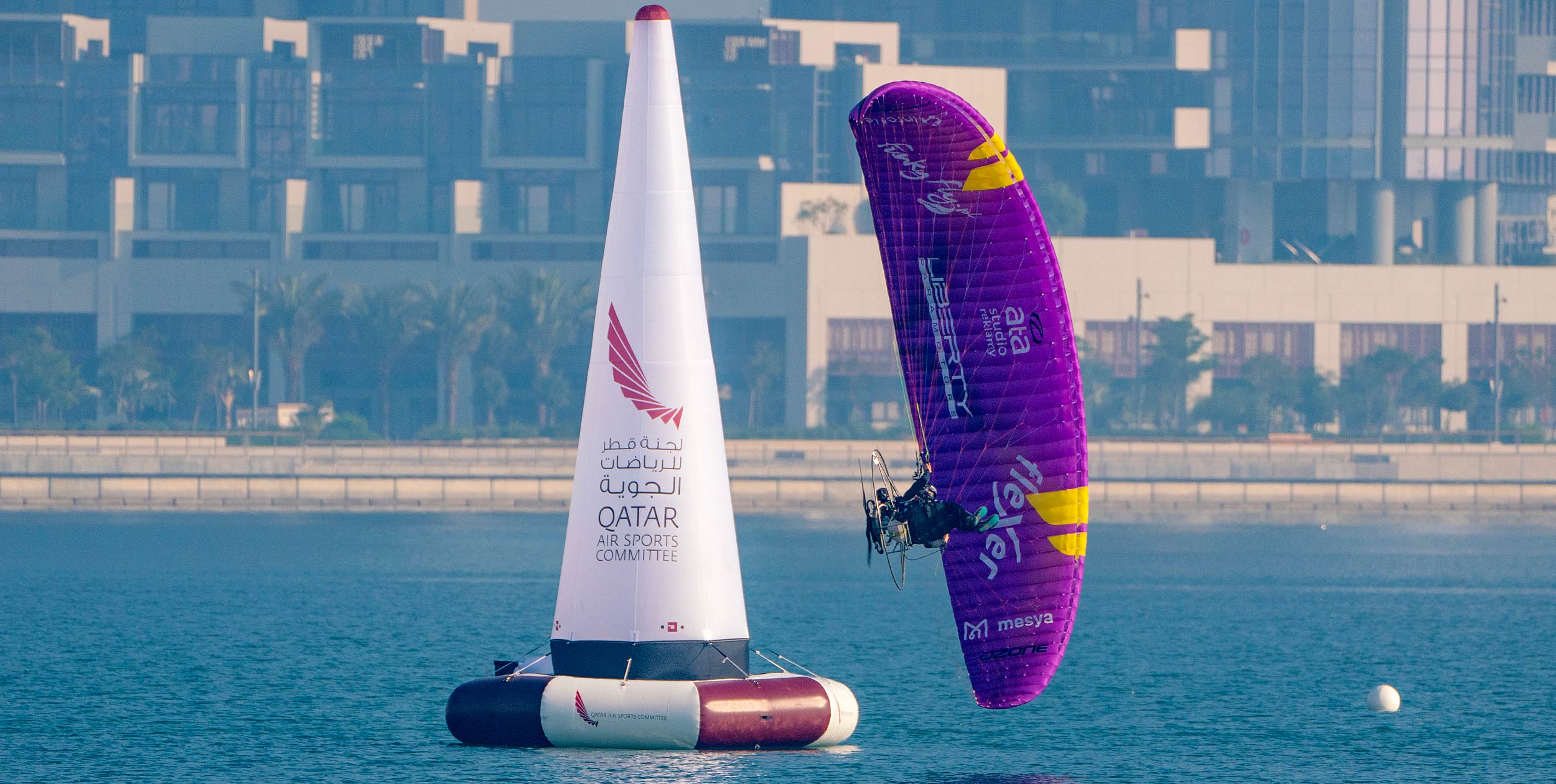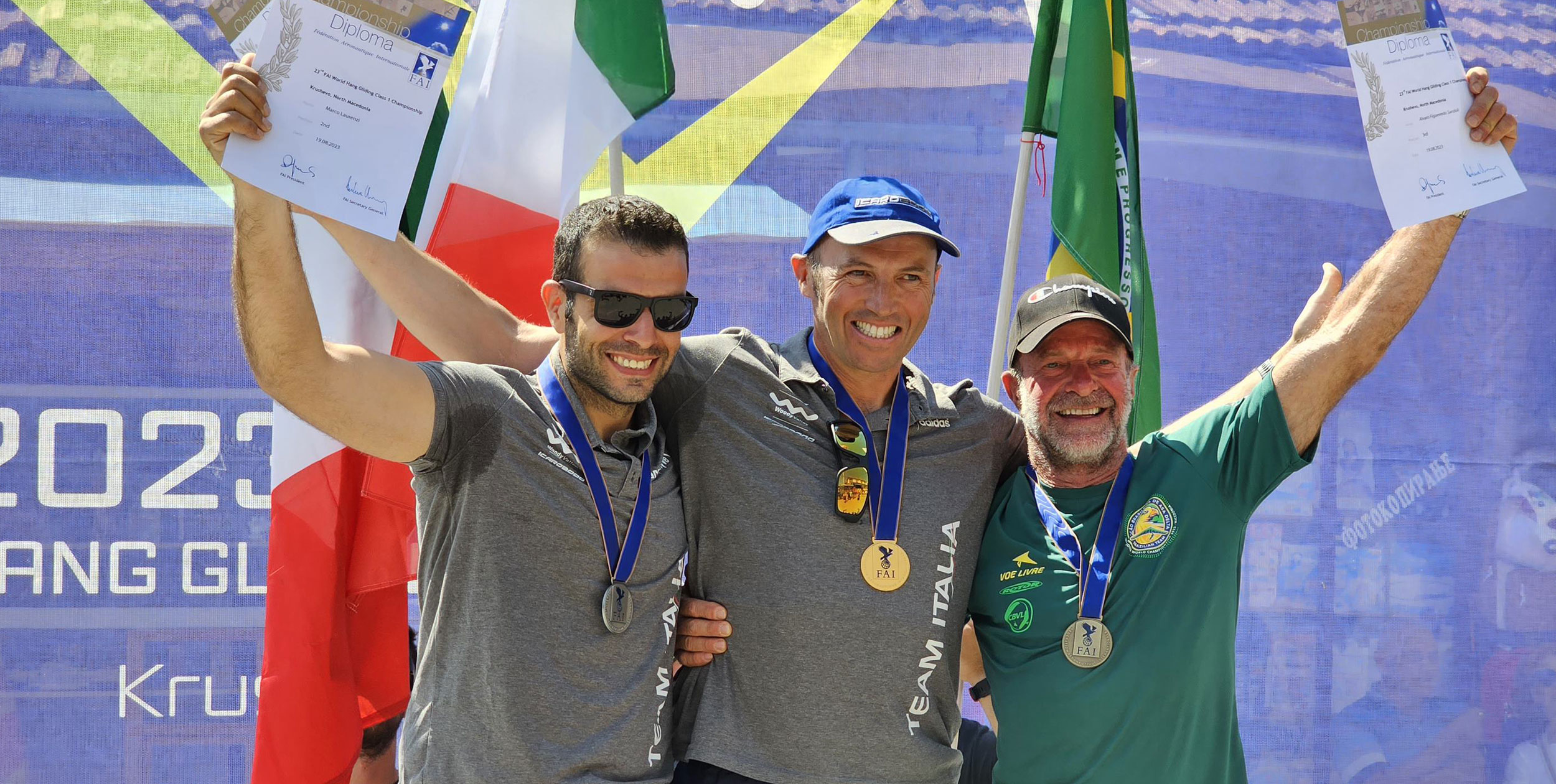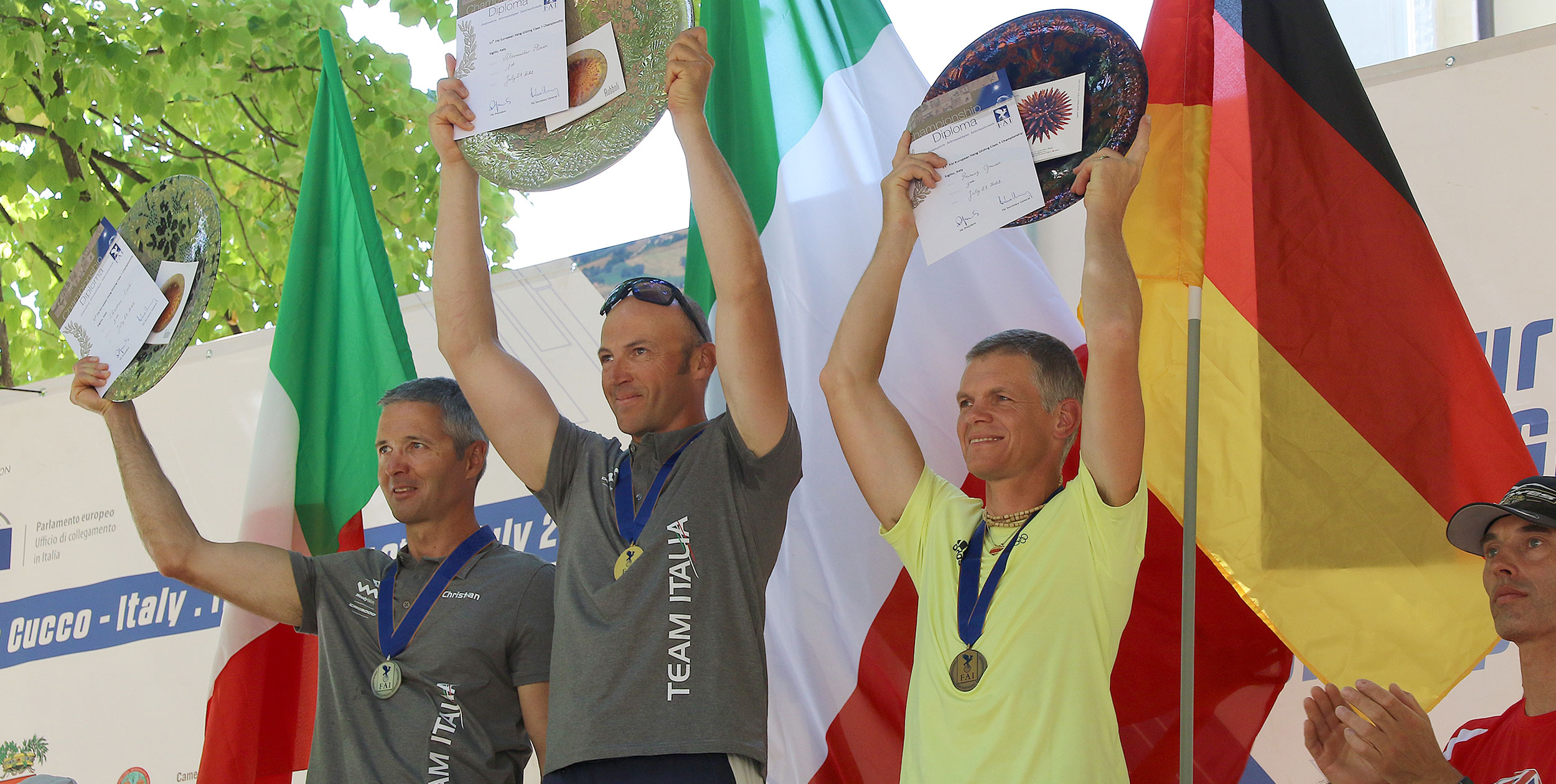Few pilots dispute that Alex Hofer, the 2002 PWC Champion, is the best competition pilot in the world, and few were surprised by his win at the 2003 Paragliding World Championships. Ian Blackmore went to watch the action unfold in stable, difficult conditions at Montelegre, Portugal…
After a manic session finishing off issue 88, my good friend Kevin (aka, The Seal), and I caught the late plane to Madrid in Spain, collected the trusty hire car, and drove all through the night to Montelegre in northern Portugal.
I must confess though that I was not absolutely certain where Montelegre actually was. As the miles rolled by it slowly dawned on the Seal that, a) I didn’t know where we were going, and b) we had nowhere to stay when we got there. Thankfully, rather than complain, (which he is rather skilled at), he fell asleep.
After hours on some of twistiest, emptiest and smoothest roads I’ve ever seen, night slowly receded and a sign for Montelegre appeared in the pre dawn light. We had little idea what to expect. My research had consisted solely of asking Mark Watts what the place was like: “Small hills, weak thermals, sea breezes and not very exciting!”
“So why are they holding the world’s there?” I asked. “Because it’s safe, they’ve had so many accidents and deployments in recent worlds that I think they chose somewhere you can’t fly!” Mark is a bit of a fan of strong conditions so I took this damning indictment with a pinch of salt.
We stopped to admire the view (read: bathroom drill) so I wandered off into the bushes carrying my camera. Strolling down a track on the outskirts of town I arrived on a hill overlooking the town to be greeted by one of the most beautiful sights I’ve ever seen. A sea of mist flooded the valley, with trees and buildings poking through into the crepuscular light. The Seal of course, was asleep, and missed it.
Rolling into Montelegre which translates as ’happy mountain’, holds no surprises for the well travelled pilot. About the same size as Piedrahita it is a typical, pretty, provincial town set deep in the mountains of Northern Portugal. We’d missed the start of the competition by several days and it was also so early that there were absolutely no signs of life. Thankfully, there were road signs directing us to the comp headquarters and the main take off, ’Larouco’.
Since there was nothing happening in town we wandered up the mountain to check out the take-off. The first thing that struck us about the main launch was the effort that the organisers had obviously gone to for the competition. They had actually planted and watered a lawn on the main launch that was worthy of a good tennis court, smooth short grass and not a rock or hazard in sight, other than the long line of portable toilets, on top of a mountain. A civilised competition? Surely that’s a first.
Spirits raised, we returned to comp headquarters, collected our press passes and went to find the pilots, who were complaining about the previous day’s launch at Chavez. Phil Broers was grumbling about drug testing.
The UK’s Adrian Thomas takes us through the first couple of days…
Day 1
Cancelled due to bad weather. Typically, the weather had been perfect for the previous week!
Day 2
Task cancelled. The wind failed to blow the correct direction for the main prepared launch and the north launch at Larouco is tiny. The organisers came up with a task, and then chickened out of having 150 pilots launching from such a small hill. In the end, lots of pilots flew the task and conditions were described as, “very nice”.
Day 3, Task 1, 56.5 km
Valid task from Larouco’s south launch to Chavez. This was a great race in quite nice conditions. The main problem was that the task setters didn’t organize any way to separate the pilots at launch. There was a lack of clearance and everyone ended up in one thermal directly over launch within 500 metres of the top of the hill, it was horrible. After that the race was set via several turnpoints aimed at getting the pilots to follow the roads.
The final leg along the ridge to Chavez was into a strong headwind, which spread everyone out quite nicely. All in all, a good task with an amazing goal field on the runway of the local airfield.
Sadly, the organisers got the order of pilots arriving in goal wrong. A few arguments then ensued over who crossed the goal line first since the GPS times can vary with older models and the GPS results turned out to be incorrect. To top it all the organisers gave out beer in the goal field, and then decided to drug test the top five.
Day 4
Task Cancelled due to strong winds. Most people flew anyway and were amazed to see some guy flying around on an eight m2 Advance kite. It was quite spectacular with a 60 km/h trim speed and went past comp wings as if they were standing still. It didn’t thermal very well but hey, it went up!
Day 5
Task Cancelled again, too much wind.
Day 6, Task 2, 42.4km
Chavev to Marandela. Due to the size of the Larouco launch in this direction it was decided to go to Chavez, which is only big enough for five gliders. The top twenty were allowed to launch first and everyone else had to wait. Caroline Brille struggled to launch in the fickle conditions, and ended up blocking one lane for quite a while. Once the top guys were away there was no formal queue and chaos ensued hitting some pilots very hard.
Russel Ogden ended up with the fastest elapsed time from the start gate to the goal, but scored badly since he, like many others failed to launch until after the start had opened due to the chaos. I thought the course was somewhat bizarre, it started as a six km triangle with two km legs, then blasted off in a straight line from there to the goal. This was the easy bit as there were enormous dust devils lined up all the way to goal, so you could just join the dots.
In goal, a mere five minutes separated the first fifty three places, and only another five separated the next fifty. When you eventually managed to launch it was very full on racing.
Day 7, Task 3, 79.8km
Two things were notable about this day, the task setting and organising the queue. The teams agreed to a queueing system at that morning’s meeting. The queue would be in order of pilot’s position in the comp.
So, straight after the briefing, the Germans got in their bus, raced to Chavez, and set all their pilots up on launch. They then put in a protest saying that you couldn’t change the start system once the comp was in progress insisting on a random start and getting all their pilots off first. It left everyone apart from the Germans fuming.
Anyone who was committed to the organisations transport was doomed to be at the back of the queue. The top 10 nations were Ok, but everyone else was in trouble.
Looking at the sky, there was obviously a convergence line above launch, but set up at 90º to the course. As soon as you set off, you encountered a headwind, which got stronger as you moved away from the convergence. Most pilots spent three hours in the air and managed only 11 km.
Jean-Marc Caron pulled off an absolute blinder and in seven hours flying managed to make 72km. This was probably the best flight of the whole competition-but he got a mere 148 points for it. The next pilot managed only 19km. The rest of us just pointed into wind and flew on full bar until we reached the ground.
Day 8, Task 4, 63.7km
Another valid task from Larouco to Marandela. This was a straightforward comp task and Alex Hofer won the day. The crux of the task was getting past Chavez against the headwind.
Day 9, Task 5, 43.9km
Some 111 pilots reached goal. This was an extraordinary task where the winner had an average ground speed in excess of 60km/h for the whole of the speed run. Many pilots saw over 90 km/h groundspeed on their GPS’s. The wind was increasing with a front due to come in but a convergence set up right over launch.
Sensibly, due to the wind, they sent us on a task straight downwind and along the convergence line. The longer you stayed on the ridge, the higher the base and the stronger the tail wind when you left the ridge and started the speed run. Most people did it in one hour. The winner managed 45km in 45 minutes.
Angus Patters however, made the most exciting flight of the day. He got stuck on the ridge until it clouded over. The climbs basically stopped – except for one, caused by a small forest fire. He went into it at a couple of hundred metres, and with smoke and flames around him, climbed out to base. I don’t think he climbed again all the way to goal and sadly arrived in goal after the goal closed time.
Day 10, Task 6, 100.3km
Chavez again. This was a speed run with the task set at 90º to the convergence, which ran straight to Larouco from launch. The second turnpoint was also set at 90º to the convergence, and as a result nobody did really well and went down on the way to the second turn point, the task got 780 points for 36km.
It was simply a case of getting high and gliding as far as possible against the headwind. Frank Brown did reasonably well by diving to the right of track into the mountains, and using strong leeside climbs to work his way forward ridge by ridge. He took a bit of a kicking in the lee, but it was a very cunning plan all the same. I watched him set off into the mountains and thought, “Yeah that’ll work, but I don’t want to do it”.
Looking at the competition as a whole, Frank Brown was clearly flying very well and also Phillipe Caron. Phillipe was flying extremely fast, whilst Frank was being careful and tactical. Overall, the competition must have been fair, since the man who is undoubtably the top paraglider pilot in the world today won the competition.
Over the next two days, strong winds, low cloudbase and occasional light rain put pay to any chance of further tasks and Alex Hofer took the well deserved title of World Paragliding Champion and Petra Krausova put in a strong performance to take the women’s crown and finish a creditable 18th overall.
There was only one injury in the competition when the American teams wind dummy broke his wrist and ankle landing hard on a road. Fiona McCaskill threw her reserve one day, it failed to open, the glider recovered and she carried on.
Most pilots put the lack of accidents down to tighter restrictions on entry this year.
With only five pilots allowed per team the selection was much more critical, and all agreed the standard of piloting was much higher, making a welcome change from the last world’s in Sierra Nevada where virtually ten percent of the field ended up in hospital.
Portugal is a wonderful place to fly. Free flying you’d have a lovely time, the food is good, the people are friendly and lifts were easy. Montalegre is really good place to fly but the organisation was not quite up to the level required for a world-class competition. The organisers were excellent and could not do enough to help. Unfortunately they were let down by poor task setting and having to use the ill prepared launch at Chavez.
OVERALL RESULTS
Men
1 Alex Hofer UP Targa CH
2 Frank Brown Boomerang 3 BRA
3 Masataki Kawachi Boomerang 3 JPN
4 Kaoru Ogisawa Boomerang 3 JPN
5 Helmut Eichholzer Boomerang 3 AUT
6 Stephan Morgenthaler Boomerang 3 CHE
7 Scotty Marion Boomerang 3 USA
8 Christian Tamegger Boomerang 3 AUT
9 Nicolay Shorokhov Boomerang 3 RUS
10 Christian Biasi Boomerang 3 ITA
Women
1 Petra Krausova Mac Magus CZE
2 Nicole Nussbaum Boomerang 3 CHE
3 Louise Crandal Boomerang 3 DNK
Teams
1 Switzerland
2 Austria
3 Germany
Cross Country quizzed the new world champion Alex Hofer on his win, tactics and flying the Montelegre flatlands
Tell us about the competition Alex
When I went to Montelegre I really wanted to win. But I wasn’t feeling very confident about flying in flatlands and the fact that the flying might be quite slow. In the first task I got stuck early on and was right down to about 50 metres above the ground at one point.
I managed to climb out again but it was very close and everyone below me landed. The second task went much better and I came second and started to feel better but then in the third task I finished 75th. I was very angry with myself but fortunately the task didn’t score well, so it was not such a disaster as it could have been.
The next task I was still very angry with myself and flew very aggressively and much better. The last two tasks were quite difficult, but my main competitors, Achim and Norman, dropped down the rankings, which helped me to win.
What do you think gave you the edge over the other competitors?
I fly heavier than most pilots so I can accelerate well for the final glides. I’ve been doing well recently, so I don’t find being in the lead is anything special anymore. This is a big help in remaining calm when I’m in the lead, and helps me keep making good decisions.
Who were your main opponents?
Last year it was Scotty Marion for sure, but this year, Norman Lausch was easily my strongest opponent. When we flew in a group he was always above me.
I simply could not beat him in the same group. The only way to beat him was to let him get just ahead of me, let him set off on a route, and then for me to take a different route. I had to split the gaggle and be in a different gaggle to Norman.
Others would follow me, and Norman would never turn back to follow my route. It was sort of a point of honour for him not to turn back. On the last day Frank was quite a challenger and could maybe have beaten me. I had landed short and watched Frank fly over me. I just had to watch him fly on and hope he wouldn’t find another climb. He didn’t.
What did you think of Montelegre?
I’m an Alpine pilot. I like big mountains and stronger conditions so it was not my favourite place. It was not superb but better than expected. The main advantage it had was that it’s not very dangerous so there were no accidents.
• Got news? Send it to us at news@xccontent.local. Fair use applies to this article: if you reproduce it online, please credit correctly and link to xcmag.com or the original article. No reproduction in print. Copyright remains with Cross Country magazine. Thanks
Subscribe to the world’s favourite hang gliding and paragliding magazine







